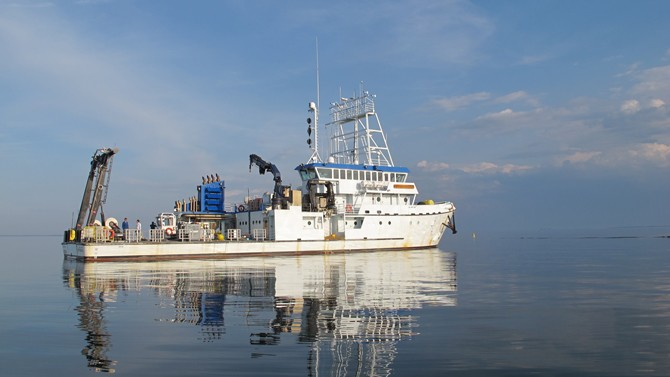搜索结果: 1-15 共查到“海洋科学 Chesapeake Bay”相关记录21条 . 查询时间(0.053 秒)

Keeping an eye on ocean acidification in Chesapeake Bay(图)
ocean acidification Chesapeake Bay
2017/9/5
A research team, led by University of Delaware professor Wei-Jun Cai, has identified a zone of water that is increasing in acidity in the Chesapeake Bay.The team analyzed little studied factors that p...
Nutrient loading and meteorological conditions explain interannual variability of hypoxia in Chesapeake Bay
Nutrient loading meteorological conditions Chesapeake Bay
2014/4/2
We use geostatistical universal kriging and conditional realizations to provide the first quantitative estimates,
with robust estimates of uncertainties, of the seasonal and interannual variability i...
Seasonal and interannual change in a Chesapeake Bay eelgrass community: Insights into biotic and abiotic control of community structure
Seasonal and interannual change Chesapeake Bay eelgrass community Insights into biotic abiotic control of community structure
2014/4/17
We characterized the seasonal and interannual variation in macrophytes, epiphytes, invertebrate herbivores, small demersal predators, and physicochemical characteristics of an eelgrass (Zostera marina...
Non-Tidal Variability in the Chesapeake Bay and Potomac River:Evidence for Non-Local Forcing
Non-Tidal Variability Chesapeake Bay Potomac River Non-Local Forcing
2009/2/23
Non-tidal variability in the Chesapeake Bay and Potomac River, and its relation to atmospheric forcing, is examined from two-month sea level and bottom current measurements. The dominant sea level flu...
Wind-Driven Circulation in the Chesapeake Bay, Winter, 1975
Wind-Driven Circulation Chesapeake Bay
2009/2/13
Nontidal circulation in Chesapeake Bay was examined from one-month current records at 50 and 200 km from the entrance. The monthly mean flow was basically a two-layered circulation; in addition, there...
Subtidal Sea Level Variations in the Chesapeake Bay and Relations to Atmospheric Forcing
Subtidal Sea Level Atmospheric Forcing Chesapeake Bay
2009/2/13
Subtidal sea level variations in the Chesapeake Bay were examined over a one-year period for evidence of wind-driven barotropic circulation. The major transport occurred at time scales of 3–5 days, wh...
Wind-Induced Destratification in Chesapeake Bay
Wind-Induced Destratification Chesapeake Bay
2009/1/9
Multiyear continuous observations of velocity and salinity in the Chesapeake Bay indicate that wind-induced destratification occurs frequently from early fall through midspring over large areas of the...
Tidal marshes as a source of optically and chemically distinctive colored dissolved organic matter in the Chesapeake Bay
Tidal marshes optically chemically distinctive colored dissolved organic matter the Chesapeake Bay
2014/4/21
The role of tidal marshes as a source of dissolved organic carbon (DOC) and colored dissolved organic matter (CDOM) for adjacent estuarine waters was studied in the Rhode River subestuary of the Chesa...
The influence of climate variation on eastern oyster (Crassostrea virginica) juvenile abundance in Chesapeake Bay
climate variation eastern oyster juvenile abundance Chesapeake Bay
2014/4/22
There has been a significant downward trend in the annual abundance (= spatfall) of 0-age eastern oysters (Crassostrea virginica) measured in the autumn since 1940 in the Maryland portion of Chesapeak...
Bacterioplankton community in Chesapeake Bay: Predictable or random assemblages
Bacterioplankton community Chesapeake Bay Predictable random
2014/5/5
We monitored bacterioplankton communities from Chesapeake Bay over 2 years (2002-2004) by use of denaturing gradient gel electrophoresis (DGGE) of PCR-amplified 16S rRNA gene. Chesapeake Bay bacteriop...
Dissolved and particulate organic matter source-age characterization in the upper and lower Chesapeake Bay: A combined isotope and biochemical approach
Dissolved and particulate organic matter source-age characterization the upper and lower Chesapeake Bay A combined isotope and biochemical approach
2014/5/4
In order to characterize the sources and ages of organic matter contributing to river and estuarine outflow waters, the present study investigated Δ14C and δ13C signatures of the major operationally d...
Cultural eutrophication in the Choptank and Patuxent estuaries of Chesapeake Bay
Cultural eutrophication Choptank Patuxent estuaries
2014/4/30
The Choptank and Patuxent tributaries of Chesapeake Bay have become eutrophic over the last 50–100 years.
Systematic monitoring of nutrient inputs began in ;1970, and there have been 2–5-fold increas...
Spatial and temporal variability in factors affecting mesozooplankton dynamics in Chesapeake Bay: Evidence from biomass size spectra
Spatial and temporal variability factors affecting mesozooplankton dynamics
2014/4/23
Zooplankton biomass in Chesapeake Bay was estimated with an optical plankton counter mounted on a towed
body (Scanfish). Normalized zooplankton biomass size spectra were calculated for three Ba...
Chemistry of surface waters: Distinguishing fine-scale differences in sea grass habitats of Chesapeake Bay
Chemistry of surface waters Distinguishing fine-scale differences sea grass habitats Chesapeake Bay
2014/5/9
We tested the hypothesis that the physical and chemical processes acting in sea grass habitats of the lower Chesapeake Bay are spatially structured and that dissolved elemental chemistry of sea grass-...
Seasonal and annual variability in the spatial patterns of plankton biomass in Chesapeake Bay
Seasonal and annual variability spatial patterns plankton biomass Chesapeake Bay
2014/5/9
We conducted high-resolution, underway sampling in April, July, and October for 6 yr (1995-2000) in the large estuary, Chesapeake Bay. This period included climatological extremes in freshwater inputs...

